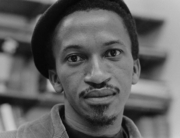![]() Greater than the sum of its parts, Cameraperson combines leftover footage from documentaries that cinematographer/director Kirsten Johnson worked on over the course of 25 years. The resulting memoir traces her career through the locations she has visited and people she has recorded. However, the professional highlights only tell part of the story, as the film also includes material from her personal life and communicates what one assumes are Johnson’s own ideas about her work.
Greater than the sum of its parts, Cameraperson combines leftover footage from documentaries that cinematographer/director Kirsten Johnson worked on over the course of 25 years. The resulting memoir traces her career through the locations she has visited and people she has recorded. However, the professional highlights only tell part of the story, as the film also includes material from her personal life and communicates what one assumes are Johnson’s own ideas about her work.
In many documentaries, the person behind the camera is an invisible presence, but in Cameraperson, we are aware of Johnson in nearly every scene. One of the earliest sequences is a long, static shot of a country road in which everything is still and quiet, until a bolt of lightning forks down through the sky. There is the subsequent crack of thunder, followed by more silence, and then, quite unexpectedly, Johnson can be heard sneezing. It’s a reminder that for every happy accident ever caught on film, there was an intermediary who decided on where to set up the camera, what angle to shoot, how long to keep rolling.
This profile offers a rich kaleidoscope of people and situations: a boxer in Brooklyn on the night of a major fight; the midwife at an impoverished clinic in Nigeria, who soldiers on through birth after birth; a family in Bosnia and Herzegovina that witnessed horrific violence against women during the Bosnian War; attorneys preparing for the trial of the men who killed James Byrd Jr.; and more. Her transitions are never jarring, as sequences placed side-by-side either blend together or contrast in unexpected ways.
Sometimes the juxtapositions serve to lighten the mood, as when a tense encounter with soldiers near a prison for Al Qaeda detainees in Yemen segues to Johnson’s children investigating her camera. At other times, they’re revelatory: a speaker at a Syrian dissident filmmakers collective makes the argument that the media’s responsibility is not to engage in voyeurism by filming dead bodies. Rather, their challenge is to stir audiences to action while maintaining the dignity of the subject. From there, the film cuts back to the prosecutors of Byrd Jr.’s murderers, who were previously asked to share photographs of the deceased’s mutilated corpse. Instead, one of the lawyers slowly pulls out of the evidence box the chain that was used to drag the victim to his death.
From scenes such as that one, we can infer Johnson’s own attitudes about the line that separates the stoking of outrage from exploitation. What’s also obvious is her sympathy towards women, minorities, and survivors of historical atrocities, not only from her choice of projects with a focus on social justice but how she relates to her subjects. We hear her admit that she’s crying as she interviews a boy who lost his brother in a rocket attack, which also left him half-blind.
There’s also a riveting sequence involving a young girl at an abortion clinic somewhere in the United States. Her face is not shown, and instead the camera focuses on her hands clutched in her lap, which start to play nervously as she explains her situation. At a certain point, we hear voices—one we assume is Johnson’s—reassuring her that she is not a bad person for the choices she makes.
In addition, there is footage of a highly personal nature, scenes of her mother, who is in decline because of Alzheimer’s, and her aforementioned children, who grow older magically between appearances. Such moments feel incredibly intimate and sometimes sad.
At other times a scene starts in a dark place and becomes unexpectedly lighter, such as when Johnson interviews the daughter of a poet who committed suicide, which necessitates the former cleaning out the mother’s home. Frustrated, the daughter starts to trash a bedroom in real time, the physical and emotional turmoil interrupted by an avalanche of snow outside that initially sounds like an earthquake, which grinds things to a sudden halt.
The film illustrates how a cinematographer can make choices that might differ from the director’s vision and so they end up excised. However, much of the footage here is so powerful it’s difficult to believe it was deemed expendable. Perhaps the most important lesson of Cameraperson, beyond the fact that Johnson has had an impressive career, is that repurposing sequences can invigorate them and add new layers of meaning. In the film originally shot in Bosnia and Herzegovina, she interviewed a family that might have witnessed systematic rape and murder. Johnson returns to the same location years later and records the same family, now older, reacting to the original footage of themselves.
During the reunion, she mentions that although the project was on an extremely dark topic, her memories are very positive because of her time spent with all of them. It’s a reminder that the footage itself is not always the chief takeaway and that there are opportunities to make connections that continue to transcend time. The film’s coda, meanwhile, is a simple sequence demonstrating how life goes on, andfootag therefore so does Johnson’s career.







Leave A Comment